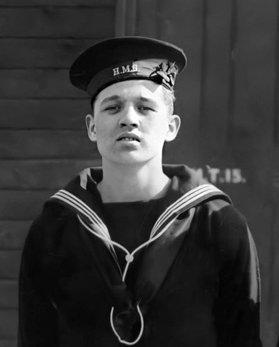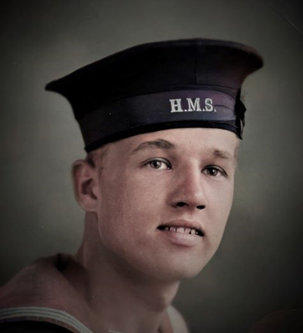
copyright © Wartime Heritage Association
Website hosting courtesy of Register.com - a web.com company
Wartime Heritage
ASSOCIATION
Remembering World War II
Name:
Harold Albert Brown
Rank:
Able Seaman
Service Number: P/SSX 33294
Service:
HM Lighter A2, Royal Navy
Date of Birth:
November 3, 1921
Place of Birth:
Kentville, Kings County, Nova Scotia
Date of Death:
October 12, 1941
Recorded as:
October 13, 1941
Age:
19
Memorial:
Portsmouth Naval Memorial
(Panel 47, Column 2)
Harold Albert Brown was the son of John Alfred Brown (b. 1897) and Helen Clara (Woodcock) Brown (1896-1979).
Harold’s father was born in Halifax, Nova Scotia. His mother – in Beamhurst, Checkley, Staffordshire in England.
Harold’s father served as a Sapper for Canada during the First World War (Service No. 489165). He enlisted with
the 66th Princess Louise Fusiliers at the York Redoubt in Ferguson’s Cove, Halifax and served with the 5th
Battalion, Canadian Engineers with Canadian Expeditionary Forces in France.
It is not known when Harold joined the Royal Navy, but one his
family’s photographs of him in a naval uniform is dated June 14,
1940 so he had joined the Royal Navy prior to that date.
Harold served in the Mediterranean theatre of war, more specifically,
in North Africa.
The British held port of Tobruk was besieged from May to October of
1941. Very little supplies could be taken in safely. Destroyers could
sometimes deliver supplies or limited reinforcements, or evacuate
wounded, but day runs were impossible with German aircraft ready
to pounce. Critical to the supply effort were “lighters” or
barges/boats run by the Royal Navy. These lighters, along with
former Italian fishing schooners, were used in the aptly-named ‘Spud
Runs’.
“The ‘A’ Lighters were based at Mersa Matruh from June 1941,
carrying vehicles, ammunition and fuel into Tobruk and, time
and enemy activity permitting, returning with cargoes of damaged equipment for repair in Egyptian
workshops, wounded and prisoners. Attack could come at any time. One A Lighter was sunk by a magnetic
mine as it approached its unloading point inside Tobruk harbour, and on another occasion 2 more were
attacked by German dive-bombers off Sidi Barrani.
Neither were mines and aircraft the only threat. In the evening of October 9, a convoy of three A Lighters,
A2 [Harold’s boat], A7 and A18, left Mersa Matruh loaded with tanks, intending to rendezvous with an anti-
submarine trawler and air cover at around noon the following day. At 04:00 on October 10, they were
attacked by a U-Boat on the surface, whose gunfire damaged the A18’s bridge, cut her degaussing cable,
carried away her mast and badly wounded her navigator. The A Lighter responded with its own armament
and A7, commanded by Sub-Lieutenant Dennis Peters, part lowered her bow ramp with the intention of
ramming but the U-Boat disappeared. The convoy then became split, with A18 limping back to Mersa
Matruh while the other two A Lighters pushed on to Tobruk. The remainder of the voyage was far from
uneventful. The air and sea cover failed to materialise and the A Lighters came under attack from a dozen
aircraft at 17:00, from two more at 22:00 and from enemy coastal guns at around midnight; to round things
off Tobruk was undergoing a heavy air raid when they finally arrived at 01:30 on October 10.
After unloading A2 and A7 sailed back out of Tobruk harbour at dusk on October 11. They were ambushed
at around midnight by U-75 lurking inshore, again using guns rather than torpedoes. A7 suffered several
hits that set her engine room and mess deck on fire, while return fire forced the U-Boat to submerge. The
A2 took the A7’s wounded aboard and put the vessel in tow when the latter’s commander, Sub-Lieutenant
Bromley, declined to scuttle her. The U-75 then reappeared and sank both vessels with gunfire. Only one
crewman of the thirty-seven men aboard the two vessels survived, being picked up by the same U-Boat
after twenty-four hours in the water...”
Harold Albert Brown died 21 days before his 20th birthday. There were also two Newfoundlanders who served on
A2 and A7 and died October 12, 1941:
Leading Seaman Weston Knee Canning (Service No. P/JX 188878), age 21.
Remembered on the Portsmouth Naval Memorial (Panel 58, Column 2)
Commemorated on Page 149 of the Newfoundland Book of Remembrance
Displayed in the Memorial Chamber of the Peace Tower in Ottawa on March 16, July 3, and October 14
From Musgrave Harbour, born in Bonavista, Newfoundland
Commonwealth War Graves Commission record
Able Seaman Cyril Garfield Simmonds (Service No. D/JX 211516), age 19.
Remembered on the Portsmouth Naval Memorial (Panel 56, Column 1)
Commemorated on Page 199 of the Newfoundland Book of Remembrance
Displayed in the Memorial Chamber of the Peace Tower in Ottawa on April 10, July 28 and November 8
Son of Cyril and Florence Simmonds, and born in, Bonne Bay, Newfoundland
Commonwealth War Graves Commission record
Of the passengers and crew of 37 from the two boats, A2 and A7, only 1 survived and was picked up by the U-Boat
who sunk the two lighters. The sole survivor was Royal Navy Petty Officer William Alfred Henley, DSM and Bar,
the Coxswain of A7. Lost in addition to the crew were an officer in the Royal Engineers, four Australian soldiers,
and two Italian prisoners-of-war, that sailed from Tobruk in A2 and A7. It is clear from the full text of the
survivors detailed narrative that many of the men of the two ‘A’ lighters who were not killed in the initial attack
were machine-gunned by the submarine as they swam helplessly in the water.
Harold died 22 days before his 20th birthday. Harold and the other lost aboard A2 actually died on October 12
but their deaths are recorded as October 13. A2 went down at 02:34 in the morning on October 12th.
Harold Albert Brown






- World War I - Menu
- WWI Stories and Articles
- Photos - Yarmouth Soldiers
- Selection of World War I Songs
- WWI Casualties of Yarmouth, NS
- Those Who Served - Yarmouth, NS
- WWI Casualties Digby Co. NS
- WWI Casualties Shelburne Co. NS
- Merchant Mariners (1915) Yarmouth, NS
- Canadian Forestry Corps - Non Yarmouth Birth/Residence Enlistments
- US Draft Registry - Yarmouth NS Born


- World War II - Menu
- WWII Stories and Articles
- Telegraphist Air Gunners
- WWII Casualties of Nova Scotia
- US Casualties with NS Connection
- Far East/Pacific Casualties with NS Connection
- Merchant Navy Casualties Nova Scotia
- Nova Scotia WWII Casualties Holten Canadian War Cemetery
- D-Day Casualties - Nova Scotia
- CANLOAN Program Casualties - Nova Scotia
- Battle of the Bulge Casualties - Nova Scotia
- WWII Casualties Yarmouth NS
- Yarmouth Casualties - RCAF RAF Canadian Army WWII
- Yarmouth Co., Marriages WWII
- Casualties Non-Born/Residents with Connection to Yarmouth Co., Nova Scotia.
- WWII Casualties Digby Co., NS
- Non-Nova Scotian WWII Casualties Buried in Nova Scotia
- WWII RCAF Casualties Aged 16-18
- Brothers/Sisters Who Served - World War II













